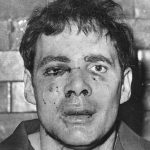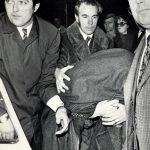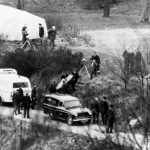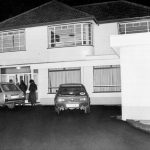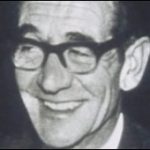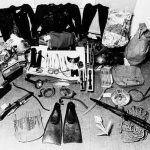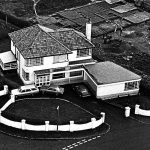
Episode 25 – The Black Panther – Donald Neilson
On December 11, 1975, two police officers, Tony White and Stuart MacKenzie, were sat in their police panda car on a side road in Mansfield, Nottinghamshire. They were observing the passing traffic, keeping a lookout out for any drivers breaking the rules—but then they noticed a man behaving strangely on the pavement on the opposite street. While it was dark and the officers could not see the man clearly, it looked as though this person was trying to hide his face when he noticed the police car. It soon dawned on Officers White and MacKenzie, that they were close to the local sub-post office. Due to the numerous armed robberies within the last three years, everyone in the force knew to be on the lookout for anything suspicious within the vicinity of post offices— so the officers decided to call the man over to question him.
At that moment, Officers Tony White and Stuart MacKenzie could not have guessed that they had just encountered Britain’s Most Wanted Man.
As PC White asked if the stranger would mind telling them where he had been, the man replied, saying he was just going home from work. He told the officers his name was John Moxton, and he lived in Chapel-en-le-Frith. PC MacKenzie had his eyes on his pocketbook as he wrote the details down—but before he even had time to finish, “John” shouted:
“Don’t move! Any trick, and you’re dead.“

For more horrifying true crime stories, please click below:
Archives
What the officers had thought would be a routine check had just turned into a hostage situation, as the man now pointed a sawn-off shotgun at them. “John” ordered PC White to move into the back of the car while he settled into the passenger seat and pushed the gun into PC MacKenzie’s armpit, telling him to drive to Blidworth. This alarmed the officers, who thought that perhaps the gunman wanted to take them to Blidworth woods where he could shoot them and escape without any witnesses. To prevent that from happening, PC MacKenzie decided to act—he turned the steering wheel violently and slammed the brakes giving PC White an opportunity to grab the gun and push it away from his fellow officer before “John” even realised what was happening. During the struggle, the gun discharged up into the roof, grazing PC White’s hand. Meanwhile, as the car was now stationary, PC MacKenzie opened the door and threw himself out of the vehicle before moving to the passenger side and dragging “John” onto the pavement. But this man was fat from giving up—he was extremely strong and fought so hard that even two officers were barely enough to hold him down. Fortunately, the wrestling took place in front of a local fish & chip shop, and two men, Roy Morris and Keith Wood, ran from the queue to help. While Roy held down “John’s” hands, PC MacKenzie managed to snap on the handcuffs—but even that did not stop him.
As John continued his fight to break free, more people joined the struggle and eventually overpowered him, attacking so furiously that the officers had to ask them to back off. Finally, “John” was dragged next to a metal railing at the side of a bus stop and secured to them using the cuffs.
After taking a few long breaths, PC MacKenzie called the incident in, while PC White carried out a body search. He made a frightening discovery from “John’s” left hip—a large hunting knife. If he had been able to grab the weapon during the struggle, the aftermath could have been very ugly. PC White also found some shotgun cartridges and a sheath knife in “John’s” left booth, in addition to gloves and a face mask.
After his arrest, “John” refused to speak to anyone and did his best to prevent the investigators from taking his fingerprints—suggesting John Moxton was not his real identity. Even the mugshot taken at the time proved useless, as “John’s” face was left looking quite rough after the wrestling match with the bystanders. However, when a forensic team examined the items found in “John’s” possession, they were able to lift several partial fingerprints—and those prints were quickly matched with those found at the scenes of the crimes committed by a criminal who had terrorised north England for the last four years. The Black Panther.
To everyone’s surprise, when Commander Morrison sat down with “John” and told him they had found matches to his prints, he began to talk. This man admitted his name was not really John Moxton but Donald Neilson.
Born in Bradford, West Riding of Yorkshire, on August 1, 1936, Donald Nappey grew up in a working-class family. His father, Gilbert, had a job in the textile industry, and his mother, Phyllis, was a homemaker. Not much has been said about Donald’s early years, but life back then was not easy for the common people, and it appears little Donald had it even rougher than others. Donald was considered a bright child at school, but unfortunately, the boy did not exactly enjoy going to school. Donald’s peers bullied him mercilessly just because of the family name “Nappey,” which was shortened to “nappy.” Such a silly thing eventually led to young Donald becoming a loner and channelling his frustration by committing minor thefts. But it was when Donald’s mother got sick that the thing really began to go downhill.
Phyllis Nappey died from breast cancer in January 1947 at just 33 years old, leaving 10-year-old Donald to grow up faster than he should have. The boy’s father was working long hours, having no time to look after Donald, who then began to rebel even more. Whenever he could, Donald skipped school and continued his petty thefts. Eventually, around a year after his mother’s death, Donald was finally arrested for the first time after breaking into a shop—but due to his young age, he was let go and only given a police caution.
By the age of 17, Donald had dropped out of school and began working a dead-end job within the building industry while partying on weekends and having no real direction in life. But when Donald turned 18 and was called up to perform his two-year National Service with the King’s Own Yorkshire Light Infantry, the teenager found his calling. Somehow, under all the discipline and regimentation, Donald felt more at home than he had felt for a while—and of course, the boy that used to fight with his bullies at the playground enjoyed being a soldier. Donald eventually rose to the rank of lance corporal and served in Cyprus, Aden and in Kenya during the Mau Mau Uprising. Donald loved the army so much that he could have likely remained in the military for a full twenty-two years of service—but the thing is, he loved something else even more.
In 1955, 19-year-old Donal married a woman named Irene Tate, who kept asking him to leave the army life behind and return to Bradford to settle down. Three years later, Donald finally agreed to do so and stepped back into the civilian world—just to find himself struggling very quickly. Donald was no longer responsible only for himself but had a wife to support, and making enough money proved difficult. Eventually, Donald opened a carpenter’s shop, having learned skills for the industry before his army years, but the amount of money coming in was still way less than he liked.
More pressure was soon added as Irene found out she was pregnant, and the couple purchased a small, terraced house on Leeds Road to have a proper place for a family.
Shortly after Irene and Donald welcomed their daughter, Kathryn, into the world in 1960, Donald decided to change the family name from Nappey to Neilson for an obvious reason—he did not want his daughter to go through the same torture at school he had experienced as a child. There have been several versions of the story why Donald chose the name Neilson, some saying he saw it on the side of the ice cream van. Another theory is that as Donald bought a small taxi business from a man named Neilson, it was simply practical to use that name.
So, at this point, Donald had two firms, which he hoped would be enough to guarantee a comfortable lifestyle for him and his family. But the thing is, Donald Neilson was not exactly a businessman and failed to make his firms profitable. While Donald struggled to make ends meet, he became more and more domineering and violent toward his wife and daughter. As Donald himself later said, he was the boss at home, and if things did not go his way, Irene and Kathryn were to pay. Sometimes, Donald took his family to Yorkshire Moors and made them dress up and play soldiers while he was the tyrannical commander. Eventually, Donald realised that while he was not in the military anymore, he could still use his knowledge and training not just to play dress-up with his family but to get extra income.
After careful deliberation, Donald decided to become a career criminal who would focus on burglarising local houses. And Donald did not take his new “job” lightly—he spent a lot of time searching for potential targets and planning military-style operations using his experience in the carpentry industry and army. Donald was familiar with construction work and different kinds of windows and was able to create a method that got him into any house. He used a bit and brace to drill through the window frame and bent metal rod to disengage the latch inside—simple but effective. During the planning phase, Donald investigated the residents of the home and their schedules and only made his move when he was sure the property was unoccupied. So Donald did not care if it was day or night when he began his operation—as long as he knew the house was empty, he was going in.
Donald’s methods proved very successful, and not before long, he already had a long list of victims in Bradford. Of course, a sudden increase in burglaries eventually caught the attention of the police. While the way Donald broke into the homes was far from unique, the investigators got a feeling they had a single spree housebreaker in their hands. The way the crimes were committed, the M.O gave an impression that this was not the work of an ordinary thief but someone very organised. In fact, Donald was so good at covering his tracks that people eventually gave him the nickname “The Phantom“—it was like he vanished into thin air without a trace after each break-in.
Donald knew very well that the authorities would begin to identify his M.O, and for that reason, he began to adopt a different modus operandi every few weeks in an effort to throw the investigation off. Still, at the rate Donald was hitting the local houses, it was impossible for him to continually confuse the police—especially as he still gained entry to the homes using a bit and brace. Realising he could not continue the burglaries forever and admitting the profits were not actually that good, Donal decided to up his criminal activities.
While burgling a house in Chester, Donald had stumbled upon a cabinet full of firearms and ammunition. Excited, Donald took everything with him back home and began planning his next move, which would include a lot more money than anything he had done before. By this time, Donald had a specific ‘operations’ room in the loft of his house, where he carefully prepared all his expeditions and stored his weapons and outfits—Donald liked dressing in military-styled clothing and a balaclava mask.
In 1967, Donald left his career as a housebreaker behind and started robbing sub-post offices, which he believed were perfect targets because of all the cash and low-level security. Donald had considered bank robbery too, but the risks as a lone operator were too high for his liking—a small post office with a way simpler alarm system appeared a smarter choice. In most cases, the offices only had a panic button beneath to counter or even just the telephone to alert the authorities.
Planning a sub-post office robbery was, of course, a much different process from a simple house burglary. From now on, Donald had to deal with people, and he was definitely not going to just walk into the office during broad daylight. Instead, Donald decided he would break into the sub-postmasters home located above their workplace at night. This way, he could wake up the residents and order the sub-postmaster to hand over the keys to the safe or open the safe themselves at gunpoint. After taking the money, Donald would then tie his victims before fleeing the scene. In Donald’s envision, it would be clean and fast—as long as the people involved would do as he said. Donald understood that there was a possibility of something going wrong because of that specific detail, and he was ready to deal with violence if necessary.
However, before his first robbery, Donald changed his mind after coming to the conclusion it would be better if he just looked for the keys himself without waking up the sub-postmaster. Having people involved in the operation was a huge risk, and if it was anyway possible, Donald preferred the idea of opening the safe and escaping without anyone noticing until morning. Still, Donald had to make sure he would be able to get himself out of any situation, which is why he would take the .22 pistol, a large hunting knife and a homemade garrotte with him.
At first, Donald’s new career path left behind scared or confused sub-postmasters depending on if they had woken up during the break-in or not. But slowly, as he felt the amount of cash taken was insufficient, Donald became increasingly embittered and ruthless.
In the early hours of February 10, 1972, the owner of a small sub-post-office in Haywood, Lancashire, Leslie Richardson and his wife Hilda were asleep in bed. Although the couple had already heard about a man targeting post offices, the Richardson were not too concerned as the attacks had taken place mainly in Yorkshire. But that night, at about 3:30 AM, Hilda suddenly woke up to a strange “scratching noise.” For a moment, Hilda listened but, in the end, decided to go back to sleep, thinking nothing of it.
Meanwhile, Donald Neilson, who had broken into the home and found a key, attempted to open the safe downstairs. But to his frustration, Donald had taken the wrong key and was forced to return to the bedroom—this time, Hilda, who had not yet gotten back to sleep, heard the footsteps. Too scared to look, Hilda awoke her husband, who immediately noticed an intruder in the shadows. Leslie did not think twice but jumped out of bed and attacked Donald while telling Hilda to run.
In the midst of the struggle, the masked man pointed a sawn-off shotgun at Leslie and told him, with a fake West Indian accent, that the weapon was loaded. Leslie, however, did not let Donald threaten him and instead grabbed at the gun, which went off twice, blowing a hole in the ceiling. Leslie also managed to pull off Donald’s mask before being kicked in the groin several times. While Leslie fell to the ground in agony, Donald escaped into the night out the back door. As Hilda had already called the police, several patrol cars arrived at the scene shortly after—narrowly missing Donald.
Leslie and Hilda both provided the police with the description of the intruder, but unfortunately, their accounts were inaccurate, and the sketches made by the forensic artist proved unhelpful. Still, the most important thing was that the Richardson’s had survived the attack—not everyone was going to be as fortunate. Donald was very well aware he had barely avoided being caught—he could not let something like that happen again.
Within the following two years, the sub-post office robberies continued while the police were no closer to apprehending the perpetrator. Donald had learned from his mistake and used even more time planning and preparing for each crime. He had also begun to cut the telephone lines of the properties to ensure his victims could not alarm authorities before he was long gone. In addition, Donald swore to himself that if he ever faced an issue with a sub-postmaster, he would pull the trigger immediately.
On the night of February 15, 1974, Donald broke into another sub-post office on the outskirts of Harrogate, New Yorkshire, after selecting the location as a possible target a few months earlier. The office was owned by Donald, and Johanna Skepper, who the nightly intruder thought were deep in sleep by the time he entered their office. But as Donald carefully ascended the stairs, found his way to an upstairs bedroom and slowly opened the door, he was surprised to see the Skeppers sitting on their bed, wide awake. For a brief moment, both parties froze as they stared at each other before the sub-postmaster shouted, “Let’s get him,” and attempted to jump out of bed—but before he was able to do so, a loud sound tore through the air, followed by Joanna’s scream. Her husband had been shot once in the chest and now lay heavily bleeding next to her while Donald fled the scene through a window without a single penny.
Just when he made it back to his car, Donald heard the police sirens and knew he could not jump behind the wheel and speed off. Instead, Donald had to play it cool and drive away as calmly and inconspicuously as possible.
Meanwhile, the first responders who arrived at the sub-post office quickly knew there was nothing to be done to save Donald Skeppers’s life. And so, he became the first casualty related to the post office crime spree—but unfortunately, as the authorities now feared, he would not be the last.
While it was the utmost priority for the police to catch the killer before he could strike again, there was little to no progress in the case during the following months. The people of the area were expecting results after such a senseless and cold-blooded crime, but it seemed that the sub-post office bandit was always one—or ten—steps ahead of the police. Donald was smart enough to keep a low profile after his first murder, but eventually, it was time for another robbery attempt.
On September 6, 1974, Donald targeted the sub-post office in Higher Baxended near Accrington, Lancashire, which was run by Derek Astin and his wife, Marion. That night, the couple had just gotten in bed and were ready to go to sleep when an intruder wearing black clothing and a mask suddenly appeared in their doorway. Again, things did not go exactly as Donald had planned—instead of freezing at the sight of a gun pointed at him, Derek got up and went to tackle the masked intruder without thinking twice. A struggle ensued, which spilt out onto the landing and woke up the Astins’ two children. Marion tried desperately to assist her husband, passing him a vacuum cleaner to use as a weapon—but it was no use against a gun. The pistol went off, and Derek fell to the ground while Donald made his escape through the back window.
Derek was taken to the hospital, but unfortunately, he succumbed to his injuries soon after. Following her husband’s death, Marion gave an interview to a local TV station, describing the killer by saying he was dressed in all black and “quick as a panther.” Marion’s words stuck with the reporters—as it always happens in high-profile cases, they needed a catchy name for the perpetrator. And so, from this point forward, the sub-post office bandit became known as “The Black Panther.”
After the second casualty in the case, the police established an incident room in Accrington and began going through files of all unsolved robberies. Soon, they discovered thirteen similar enough crimes that were believed to be committed by the same person—The Black Panther. It became very clear that this person was not just an occasional criminal but someone who would not stop unless they were caught. And, they did not care how many people they killed in the process. So, not wanting to lose any more of their employees, the Post Office offered a £5,000 reward for information leading to the arrest of the Black Panther. Soon after, Donald struck again.
After another failed robbery, Donald was desperate for money, and so on the evening of November 11, 1974, he targeted the sub-post office at Langley Green, Oldbury. This time, Donald did not break in—after the two fiascos, he had realised he needed to change his strategy. Instead, Donald simply knocked on the door.
The owners of the office, Sidney Grayland and his wife, sub-postmistress Margaret, had just about to finish their day at about 6 PM when they heard a sound on the back door. Perhaps thinking a client had run a bit late to take care of some important business, Sidney went and opened the door—just to be confronted by a man in a black mask. A brief struggle ensued, during which Sidney squirted ammonia into the attacker’s eyes. Outraged, Donald raised his gun and shot Sidney in the stomach before ripping off his now wet mask. While Sidney lay on the floor dying, Donald turned to Margaret and ordered her to hand over the key to the safe—but the poor sub-postmistress was too shocked and scared to move. This infuriated Donald even more, who then violently attacked Margaret, beating her to the edge of unconsciousness before finally retrieving the key. While the Graylands lay motionless, Donald stole £800 from the safe—which is about £7,700 in today’s value—before making his escape.
A few hours later, at about 11 PM, two police officers were walking past the sub-post office and got a feeling something was not quite right. Even though the office should have been closed already, there was a light inside. The officers decided to investigate and discovered severely injured Margaret—her husband had already died of his injuries. Margaret was taken to the hospital, where she lay unconscious for several days with a fractured skull but eventually physically recovered from the attack. Unfortunately, despite seeing the Black Panther’s face up close, Margaret was unable to describe him to the police.
Following Sidney Grayland’s murder and brutal beating of his wife, the Post Office increased the reward for information leading to arrest to £25,000. While the pressure upon the police intensified, Donald decided once again to change his M.O, and this time, he would do something much more ambitious.
Lesley Whittle
Donald had grown frustrated with the poor return from the post office robberies, just like from the house break-ins before that. In addition, he had already needed to kill three people and had barely escaped during some of the attacks—the sub-post office robberies were simply not worth the risk. Instead, Donald wanted to do something big, something that would secure him financially for at least a year or two so that he did not have to keep committing crimes every month.
Back in 1972, Donald had read an interesting article about a man named George Whittle, detailing how members of his family were in a dispute over his will. George had accumulated a fortune with his and his two brother’s coach and bus company. Upon his death in 1970, George left money and assets worth £250,000 (£3,6 million in 2022) to his partner Dorothy and their two children, Ronald and Lesley—but there was someone else who wanted their share. Before meeting Dorothy, George had been married to a woman named Selina, and despite the fact they had not been a couple for more than thirty years, she considered some of her ex-husband’s wealth belonged to her. In the end, after legal proceedings, Selina was granted £1,500 (about £20,000 in 2022) and a £30 a week allowance. But while the dispute was the reason why the whole ordeal ended up in the news, it was not Selina who Donald was interested in.
On the evening of January 13, 1975, Dorothy left the family home in Highley, Shropshire, to visit friends. When she returned at 1:15 AM, Dorothy found her 17-year-old daughter Lesley sound asleep in her bed. Dorothy then took a sleeping pill and retired to her own room.
Not even an hour had passed before a strange car parked nearby the house. Donald Neilson got out wearing his usual attire and entered the Whittle family home via the attached garage. He then chose one of the four bedrooms, which happened to be Lesley’s and woke the girl up while pointing a gun at her. Terrified, Lesley followed Donald’s orders—she quietly got out of bed, put on a dressing gown, and allowed the stranger to apply surgical plaster over her mouth and tie her hands behind her back. Donald then directed the teenager out of the room and down the stairs before they both disappeared into the night.
The following morning, Dorothy went to her daughter’s room after noticing she had not yet come down and would soon be late for college. Oddly, she found Lesley’s bed empty, but she was also nowhere else inside the house—Dorothy knew her daughter, and she would have never gone out without letting her know. Dorothy then tried to call her son, Ronald, who lived on the other side of the village, but the phone was not working. Starting to panic, Dorothy drove to Ronald’s house and soon returned with Ronald and his wife Gaynor, who had promised to help to look for Lesley. As the three thoroughly searched the family house, they discovered rolls of printed Dymo-tape in a confectionery box in the living room. The tape read:
“NO POLICE. £50,000 RAMSON TO BE READY TO DELIVER FIRST EVENING WAIT FOR TELEPHONE CALL AT SWAN SHOPPING CENTRE TELEPHONE BOX 6PM TO 1AM IF NO CALL RETURN FOLLOWING EVENING WHEN YOU ANSWER GIVE YOUR NAME ONLY AND LISTEN YOU MUST FOLLOW INSTRUCTIONS WITHOUT ARGUMENT FROM THE TIME YOU ANSWER YOU ARE ON A TIME LIMIT IF POLICE OR TRICKS DEATH £50,000 ALL IN USED NOTES £25,000 IN £1 NOTES AND £25,000 IN £5 THERE WILL BE NO EXCHANGE ONLY AFTER £50,000 HAS BEEN CLEARED WILL VICTIM BE RELEASED DELIVER £50,000 IN WHITE SUITCASE
SWAN SHOPPING CENTRE KIDDERMINSTER“
Despite the kidnapper’s warning, Ronald decided to contact the police before contacting the bank. After withdrawing the £50,000, the notes were copied at the police headquarters so they could be traced—but taking that money to the kidnapper proved unnecessarily difficult. Due to a series of police bungles and other circumstances, Ronald missed the first call, and when he finally got the instructions from the kidnapper on two different occasions, he either arrived at the agreed spot too late or Donald saw a police vehicle and abandoned the ransom drop. It was just a mistake after a mistake, all while Lesley Whittle lay alone in the drainage shaft of the nearby reservoir.
Then, Donald broke into the old Freightliner Terminal yard in Dudley where he was planning to arrange yet another ransom drop—but came face-to-face with a security guard Gerald Smith. As Gerald turned around to run for a phone, Donald shot him six times in the back before fleeing the scene on foot and leaving behind his stolen getaway car. Gerald was terribly injured but still alive and was taken to a hospital where he lived for a year before his body eventually shut down.
As the police searched the car, they found ammunition for a .22 pistol, Lesley’s slippers, plastic tape and a cassette tape with her voice on it. On the recording, the teenager said:
“Mum, go onto the M6 North junction 10 and onto the A454 towards Walsall. Instructions are taped under the self of a telephone box. There’s no need to worry, Mum, I’m okay. I got a bit wet but I’m quite dry now. I’m being treated very well. Okay?”
Sadly, by the time the tape was found, it was too late to follow the instructions. Also, to everyone’s horror, the investigators matched the ammunition found inside the vehicle to the crimes of the Black Panther—they already knew this person was ready to kill, and every passing day made it less likely to find Lesley alive.
Unfortunately, days kept going by without signs of Lesley, and then weeks and eventually a month. It was not until police decided to search Bathpool Park again, which was one of the ramson drop locations, that there was a break in the case.
On the morning of Friday, March 7, Detective Constable Philip Maskery headed out to investigate the concrete-covered shafts which were part of the ventilation system for the Herecastle Tunnel. He climbed down the ladder of one of the shafts and discovered a metal ledge at a depth of nearly six feet below ground. On that ledge was a foam mattress and a sleeping bag—but what really caught Detective Maskery’s attention was the metal cable anchored to the wall that stretched over the edge. Detective Maskery had a bad feeling, but as he looked down, he was heartbroken to discovered Lesley Whittle’s naked body hanging below the ledge.
Donald had used the cable to restrain Lesley and prevent her escape—had he pushed her off the ledge. The alternative scenario was that Lesley had accidentally fallen to her death after Donald abandoned her in the shaft. No matter which theory was correct, Lesley had still died from vagal inhibition—meaning the shock of the fall had caused her heart to stop, and fortunately she had not been strangled to death. Lesley was small, and the drop alone had not been enough to break her neck. The subsequent autopsy concluded Lesley had been alive for at least three days after her abduction based on the fact her stomach and intestines were completely empty. Understandably, the poor girl had been too terrified to eat the soup and chicken, that was found on the ledge next to her sleeping bag.
After the horrifying death of Lesley Whittle, the search for the Black Panther became even more frantic. All of a sudden, Donald Neilson was Britain’s Most Wanted Man, with more than 800 officers working on the case—but, despite all the evidence found at the crime scenes, the police were no closer to catching him. At this point, they needed a miracle, a stroke of good luck… before the Black Panther could set his sights on any more victims.
Capture
Some months later, in December 1975, that stroke of luck came when the most unexpected thing happened. After a huge struggle, the officers Stuart MacKenzie and Tony White, who had been out patrolling in Mansfield, brought a man claiming to be John Moxton back to the station. John had been acting suspiciously before taking the officers hostage, before fighting for his freedom like a wild animal—almost shooting one of the officers in the head and nearly grabbing a large hunting knife from under his coat before bystanders had beaten him down. When John’s fingerprints where taken, and subsequently run through the database, the police were stunned to discover that this man. After all these years, 400 house burglaries, closer to 20 sub-post office robberies and a kidnapping, they had found and arrested the infamous Black Panther.
After Donald Neilson admitted his real identity, officers searched his house. They discovered a large number of guns, other weapons, masks and gloves and a mountain of evidence linking Donald to the post office murders and the death of Lesley Whittle. The police learned that even though the Black Panther was—to everyone’s surprise—a family man, Donald was really a loner and lived for his military background and carefully planned operations. It also appeared like Donald was quite proud of the name he had been given by the public, as the officers also found a model of a black panther in his home.
Confronted with all the evidence, including his fingerprints being matched to those found in the drain shaft, Donald confirmed he really was the feared Black Panther and admitted he had killed Lesley and the sub-postmasters.
Arranging a fair trial for Donald Neilson was not an easy task, considering how famous and hated he had become, especially in the North of England. Nevertheless, he was eventually tried at Oxford Crown Court in June 1976. During his court appearances, Donald’s defence attorney Gilbert Gray QC tried to convince the jury his client may have kidnapped a teenager, but he was not a murderer. After all, Donald had provided Lesley Whittle with chicken soup, spaghetti and meatballs—he never meant her to fall for her death.
Needless to say, the jury did not buy Donald’s explanations and, just after ninety minutes of deliberation, returned with a unanimous guilty verdict. Three weeks later, convicted of the murders of two postmasters and the husband of a postmistress. As a result, in July 1976, Donald Neilson was given five life sentences and a further 61 years: 21 years for kidnapping Lesley Whittle, 10 years for blackmailing her mother and 30 years for two burglary charges and for possessing the sawn-off shotgun. All the sentences were to run concurrently.
Donald was acquitted of the attempted murder charges of Margaret Grayland and PC Tony White. Also, because the security guard Gerald Smith died in the hospital over 365 days after the shooting, Donald could not be charged with his murder—this rule was later abolished in 1996.
In 2008, Donald applied to have his minimum term reverted to 30 years, but Judge Teare, of the Superior Court of Justice, refuted the appeal saying:
“This is a case where the gravity of the applicant’s offences justifies a whole life order. The manner in which the young girl was killed demonstrates that it too involved a substantial degree of premeditation or planning. It also involved the abduction of the young girl. The location and manner of Lesley Whittle’s death indicates that she must have been subjected by the applicant to a dreadful and horrific ordeal.”
Around the same time, Donald Neilson was diagnosed with Motor Neurone Disease, and his condition deteriorated quickly. On December 17, 2011, he was transferred to Norwich University Hospital, where he died the following day, December 18, at 6:40 PM.
Donald’s death was the ultimate end to a very dark chapter in British criminal history. As detective Ray Wagg, who worked on the Lesley Whittle case, said, Donald was a merciless and determined man who killed anyone who challenged him. If it would not have been for the incredible luck of two patrolling officers and some help from brave bystanders, who knows how many more victims the Black Panther would have claimed?
Episode Credits:
Host – Rhiannon Doe
Voiceover – Kwesi
Website layout & design – Fran Howard
NEWS ARTICLES & RESOURCES
Donald Neilson: The Black Panther (Crime Briefs)
The Black Panther: The True Story
La ‘Pantera Negra’, el ladrón de Correos que mató y ocultó a una menor en un pozo
Murderer Donald Neilson, the ‘Black Panther’, dies
Legacy of Black Panther murders
The chilling story of the Bradford serial killer known as the Black Panther
Black Panther killer Donald Neilson dies
‘The Black Panther’: Profile of killer Donald Neilson
TERROR IN THE NIGHT Who was Donald Neilson and is he still alive?

